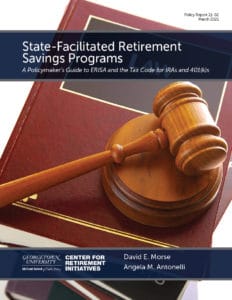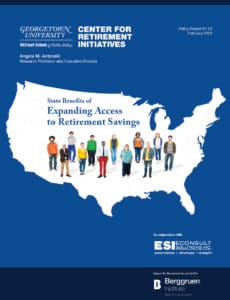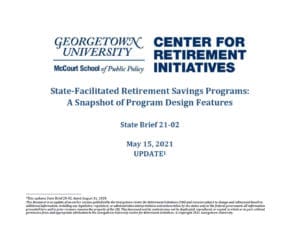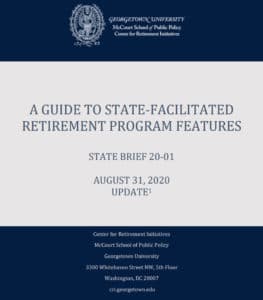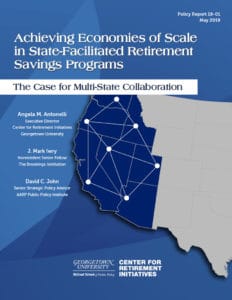Savings & Access
Please see below recent CRI work, media mentions and additional resources on the topic of retirement savings and access.
CRI Publications
This paper provides policymakers with a primer about ERISA and the Tax Code, how these federal laws and their regulations pertain to IRAs and 401(k)s, and what this means for state-facilitated retirement savings programs. After reviewing the question of ERISA applicability to state auto-IRAs and an overview of the federal Tax Code and IRA rules, it explores how ERISA and the Tax Code rules apply to 401(k)s, including the new rules allowing states (and others) to possibly lower 401(k) costs by sponsoring group 401(k)MEPs and PEPs.
State Benefits of Expanding Access to Retirement Savings (Policy Report 21-01, February 2021) | See State-by-State Interactive Map
This report provides state-level analysis of the benefits of expanding worker access to save for retirement through state-facilitated auto-IRA programs. This report follows CRI’s earlier research on the potential benefits of national universal access to retirement savings options for U.S. workers (See Policy Report 20-02). Included in the analysis are 51 state (and DC) fact sheets that provides information on key state specific metrics including demographic trends related to the aging of the population, the size of the retirement savings access gap, the projected growth in savings with an auto-IRA program, and the economic and fiscal benefits to the state of adding new savers.
What Are the Potential Benefits of Universal Access to Retirement Savings? An Analysis of National Options to Expand Coverage (Policy Report 20-02, December 2020) | Methodology Appendix
This report analyzes the potential benefits of national universal access to retirement savings options for U.S. workers. It examines how characteristics such as account type (payroll deduction IRA vs. 401(k)), the employers required to participate, and default levels of employee contributions and any employer contributions will drive access, savings, asset growth, and retirement income over time. The economic and fiscal benefits of a national approach to the universal access is enormous, contributing to significant growth in GDP and reduced federal and state spending on benefit programs for the elderly. This report draws from the experience of other countries and from the early state-facilitated retirement programs in the U.S. to make the case that universal access to retirement savings options can be achieved in a simple, cost-effective manner with private market providers ready to compete to offer options for workers.
This document provides summary information, grouped by plan design model, about the features of the current 15 state-facilitated retirement savings programs (13 states and 2 cities), including the new Virginia and New York City programs.
A Guide to State-Facilitated Retirement Program Features February 29, 2020 UPDATE) – Supporter Access Only
This comparison chart provides a more detailed summary of the features of the current 12 state-facilitated retirement savings programs (11 states and 1 city).
This final report updates and replaces CRI Working Paper 18-02, published in June 2018. This report outlines several models, based on a multi-state or regional approach, that should be explored for how states can work together to serve more than one state. Although individual states can establish their own state-sponsored retirement savings programs, the consideration of interstate arrangements offers opportunities for states to explore how they can achieve economies of scale to help minimize costs while significantly expanding access to retirement savings options.
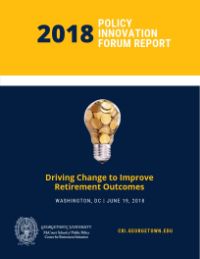 2018 Policy Innovation Forum Report: Driving Change to Improve Retirement Outcomes (CRI Policy Forum Report)
2018 Policy Innovation Forum Report: Driving Change to Improve Retirement Outcomes (CRI Policy Forum Report)
On June 19, 2018, the Georgetown University Center for Retirement Initiatives (CRI) convened an invitation-only one-day policy forum with approximately 100 senior industry leaders, policymakers, and stakeholders to examine some of the key challenges designing a retirement savings system focused on improving long-term outcomes to strengthen retirement security for millions of Americans. This report provides a comprehensive overview of the discussion held during this event, covering innovative ideas and proposals for addressing some of the challenges faced in closing the access gap, improving the design and performance of investments in retirement savings plans, and identifying ways to build and deliver more-effective and attractive lifetime income options.
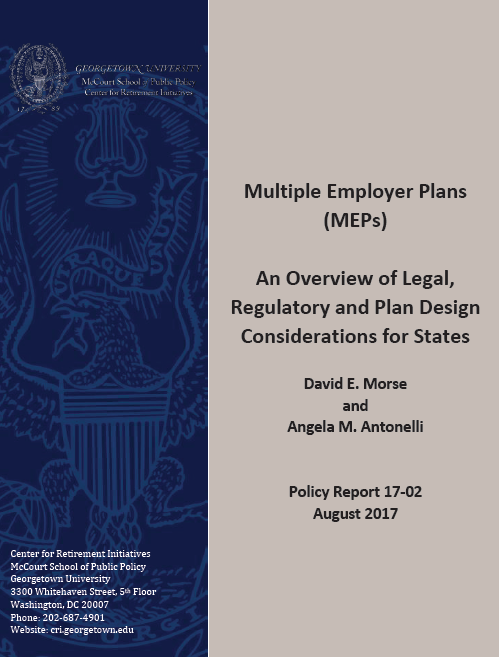 Multiple Employer Plans (MEPs): An Overview of Legal, Regulatory and Plan Design Considerations for States (Policy Report, 17-02, August 2017)
Multiple Employer Plans (MEPs): An Overview of Legal, Regulatory and Plan Design Considerations for States (Policy Report, 17-02, August 2017)
This report provides an overview of how ERISA and the Tax Code, as well as securities and other laws, would apply to a state-facilitated MEP and includes sample model legislation.
 Public Retirement Plan Options for Private Sector Employees/ Employers: A CRI Report to the VT Public Retirement Study Committee (Policy Report, 17-01, January 2017)
Public Retirement Plan Options for Private Sector Employees/ Employers: A CRI Report to the VT Public Retirement Study Committee (Policy Report, 17-01, January 2017)
This report provides an overview of the retirement security challenges facing the nation and Vermont; outlines the range of plan design options for state-sponsored retirement programs for private sector employers and employees, including legal, regulatory, and plan design considerations; and reviews some early lessons learned from other states that are in various stages of implementing new programs.
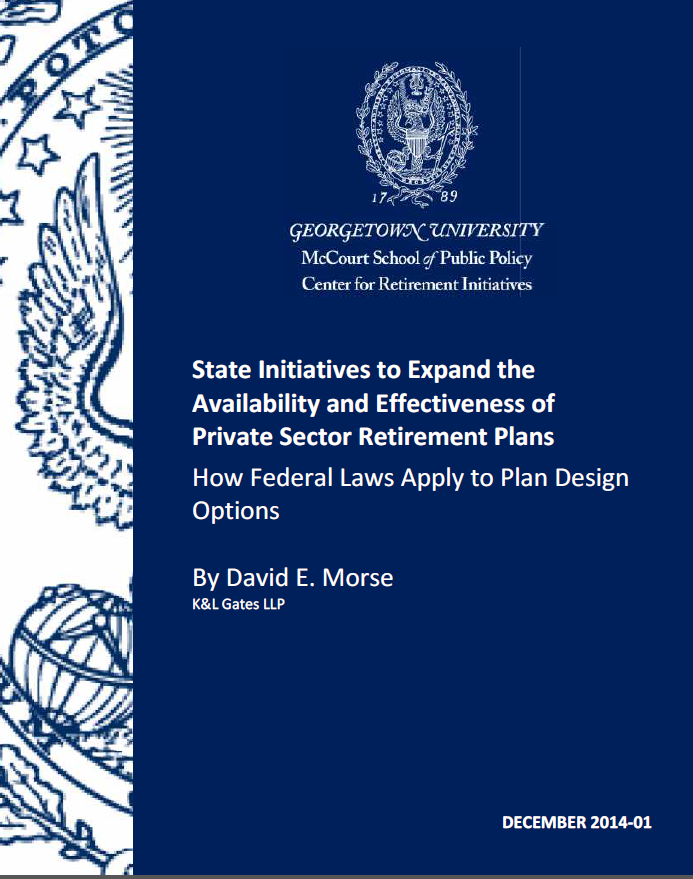 State Initiatives: How Federal Laws Apply to Plan Design Features (Policy Report, 14-01, December 2014)
State Initiatives: How Federal Laws Apply to Plan Design Features (Policy Report, 14-01, December 2014)
As states contemplate ways to help expand the availability and effectiveness of private sector retirement savings options, they must understand how ERISA and other federal laws would apply to any new program for the private sector.
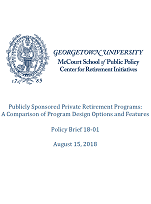 Publicly Sponsored Private Retirement Programs: A Comparison of Plan Design Options and Features (Policy Brief, 18-01, August 2018)
Publicly Sponsored Private Retirement Programs: A Comparison of Plan Design Options and Features (Policy Brief, 18-01, August 2018)
This policy brief updates an earlier 2016 Policy Brief and compares the legal and design characteristics of different state-sponsored retirement saving programs, including the Payroll Deduction IRA, Multiple Employer Plan (MEPs), Master and Prototype (Prototype), and Marketplace.
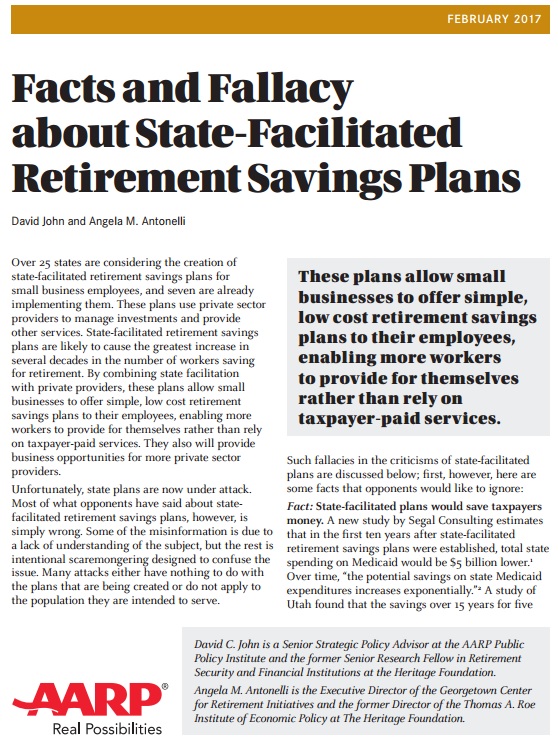 Facts and Fallacy About State Retirement Savings Plans (Policy Brief, 17-01, February 2017)
Facts and Fallacy About State Retirement Savings Plans (Policy Brief, 17-01, February 2017)
More states are considering the creation of state-facilitated retirement savings plans, but there is considerable misinformation about the different issues and programs. This brief reviews some of the fallacies and some of the facts behind state-facilitated retirement savings plans.
As a growing number of states move toward establishing retirement savings plans for private sector workers who lack access to an employer sponsored plan, policymakers and stakeholders are very interested in plan cost. States should be encouraged by findings from the financial feasibility studies conducted on state sponsored retirement plans in California, Connecticut, and Oregon. This policy brief describes the lessons that were learned from California, Connecticut and Oregon, and sheds insight into retirement saving program design construction and program structure.
 529 College Savings Plans: Lessons for Publicly Sponsored Private Retirement Plans (Policy Brief, 16-02, November 2016)
529 College Savings Plans: Lessons for Publicly Sponsored Private Retirement Plans (Policy Brief, 16-02, November 2016)
529 college savings plans have accumulated $266.2 billion across more than 12.7 million accounts. This policy brief looks at the lessons learned from the implementation of state-sponsored college savings plans and discusses some parallels for state-sponsored retirement saving plans.
Blog Posts
MarketWatch:
- Opinion: What has COVID-19 done to our retirement savings? (MarketWatch, September 8, 2020)
- When it comes to financial angst, boomers and millennials have more in common than they think (MarketWatch, December 26, 2019)
- Are millennials destined to live longer and retire poorer than their parents? (MarketWatch, October 4, 2019)
- 9 ways California’s new retirement plan changes the retirement savings landscape (MarketWatch, August 18, 2019)
- Opinion: Student loan debt makes 60 feel like the new 30 – and not in a good way (MarketWatch, July 1, 2019)
- Opinion: New solutions are desperately needed to prepare millions of Americans for retirement (MarketWatch, April 4, 2019)
- Opinion: Why planning for retirement is harder for women (MarketWatch, November 3, 2018)
- Opinion: This solution could save millions of people from poverty in their old age (MarketWatch, August 16, 2018)
- Why This Could Be One Of The Best Ways To Invest In America’s Future (MarketWatch, January 15, 2018)
- Retirement May Be Just A Dream For These Vulnerable Workers (MarketWatch, December 1, 2017)
- Why ‘Nudging’ Works: People Need A Push When It Comes To Retirement Savings (MarketWatch, October 21, 2017)
Forbes:
- 40 Million More Americans Save Can Save for Retirement by 2040 With Universal Access to Savings (March 24, 2021)
- The COVID-19 Crisis Must Accelerate The Transformation Of Retirement Savings (Forbes, May 7, 2020)
- 6 Steps To Reduce Financial Fragility And Protect Retirement After COVID-19 (Forbes, March 31, 2020)
- There Is An Easy Way To Avoid Billions In Lost Retirement Savings — But We’re Not Doing It (Forbes, February 6, 2020)
- Time to Break Down the Barriers that Prevent Americans from Choosing to Work Longer (Forbes, October 29, 2019)
- Emergency Savings Accounts Have the Power to Avoid Life-Changing Financial Disruption (Forbes, May 2, 2019)
- How Technology is Reshaping the Way Americans Prepare for Retirement (Forbes, March 28, 2019)
- How State Innovation Is Transforming Retirement Savings (Forbes, January 15, 2019)
CRI Policy Blog:
- 40 Million More Americans Could Save for Retirement By 2040 With Universal Access to Savings Angela Antonelli (April 2021)
- An Approach for Using the Refundable Saver’s Credit to Improve Retirement Outcomes Catherine Reilly (February 2021)
- The First State-Facilitated MEP in the Nation: How the MA CORE Plan is Helping Nonprofit Workers Save for a Financially Secure Retirement Massachusetts Treasurer Deborah Goldberg (November 2020)
- Staying the Course Through Turbulent Markets May Lead to Better Retirement Outcomes Jonathan Barry and Jessica Sclafani (August 2020)
- COVID-19 & Beyond: The Need to Address Retirement Savings Access in the Workplace Kevin Boyles (July 2020)
- Financial Wellness in a Time of Uncertainty: Employee Actions and Attitudes Aaron Harding (June 2020)
- Lessons from COVID-19: The Need for a More-Holistic Approach to Saving that Protects Retirement Angela M. Antonelli (May 2020)
- Making It Easy: How Defaults and Design Can Improve Retirement Savings Outcomes Brigitte Madrian (March 2020)
- Why Colorado Should Adopt an Auto-IRA Retirement Savings Program: The Economic and Fiscal Impacts of Doing Nothing Are Too Great to Ignore Dave Young, Colorado State Treasurer (March 2020)
- Auto-Portability: What it is, Why it’s Needed, and How it Will Strengthen Retirement Security Benjamin Roth, Andrew Green, and Angela Antonelli (January 2020)
- Emergency Savings: What’s at Stake for the Retirement Industry? Catherine Harvey (December 2019)
- The Impact of Student Loan Debt on Older Americans Patrick McNamara, Angela M. Antonelli and Laura Kim (April 2019)
- From Savings to Security: The Future of Innovation in DC Plan Design Angela M. Antonelli (March 2019)
- Achieving Economies of Scale in State-Facilitated Retirement Savings Programs: The Case for Multi-State Collaboration Angela M. Antonelli, J. Mark Iwry and David C. John (March 2019)
- The Next Generation of NEST Program Reforms in the UK: Anticipating Some Challenges Will Strengthen the Foundation for Continued Success Will Sandbrook (November 2018)
- “Work Hard. Save Easy.” The OregonSaves Retirement Program is Off to a Promising Start Tobias Read, Oregon State Treasurer (November 2018)
- What Does an Aging Population Mean for Economic Growth and Investing? Paula Campbell Roberts (September 2018)
- The Stress Behind the Dykes: Debating the Next Generation of Retirement Policy Reforms in the Netherlands Harry H.G. Smorenberg (September 2018)
- The Unique and Varied Challenges Women Face Planning and Preparing for Retirement Laura Kim and Angela M. Antonelli (September 2018)
- A Call to Action in Pennsylvania: The Demographic, Fiscal, and Economic Consequences of Retirement Insecurity Are Hard to Ignore Joe Torsella, Pennsylvania State Treasurer (March 2018)
- The Aging of America: A Changing Picture of Work and Retirement Angela M. Antonelli (March 2018)
- Closing the Global Retirement Savings Gap: A Tale of Two Numbers (March 2018)
- The Changing Nature of Work: More Can Be Done to Help Contingent Workers Save for Retirement Angela M. Antonelli, Christopher Woika and Laura Kim (November 2017)
- Launching OregonSaves: Early Lessons from an Innovative Public-Private Partnership Lisa A. Massena, CFA (June 2017)
- Small Businesses & Retirement Readiness: Vermont Embraces a Multiple Employer Plan Approach Beth Pearce, Vermont State Treasurer (June 2017)
- It’s Never Too Early to Save for Retirement: Strengthening Retirement Security Begins by Reaching Millennials Laura Kim and Angela M. Antonelli (June 2017)
- Congress Should Encourage State Innovation to Strengthen Retirement Security Charles E.F. Millard and Angela M. Antonelli (May 2017)
- Expanding Small Business Access to Retirement Plans David Damschen and Richard Mourdock (March 2017)
- Building a Publicly-Sponsored Private Sector Retirement System: Lessons from Australia Zachary May (September 2016)
- Delivering on Publicly-Sponsored Private Retirement Accounts: Key Considerations for Successful Public-Private Partnerships Richard Mourdock (September 2016)
- What We Know About Retirement Savings: Why Strategic Behavioral “Nudges” Make Sense Angela M. Antonelli and Yijun Yin (September 2016)
- Employees’ Financial Wellness: New Strategies for State-Sponsored Retirement Plans Annamaria Lusardi (June 2016)
- States Bridging the Partisan Divide on Retirement Security Angela M. Antonelli and David C. John (June 2016)
- State Retirement Savings Programs: Current Status, Lessons Learned and Future Prospects Supporter Access Only Angela M. Antonelli (April 2016)
- Building Effective Retirement Savings Programs for Uncovered Workers: Lessons from the UK Experience Keith Ambachtsheer and Will Sandbrook (April 2016)
- 529 College Savings Plans: Lessons for State Sponsored Private Sector Retirement Plans Andrea Feirstein (April 2016)
- Maryland: Small Businesses Want to Help Their Workers Save for Retirement James R. Racheff (April 2016)
Podcasts & Webinars
Podcasts:
- Episode 22: How ERISA and the Tax Code Apply to IRAs and 401(k)s: What Does it Mean for State-Facilitated Retirement Savings Programs? (May 25, 2021)
- Episode 20: How Would Virginia Benefit from Expanding Access to an Auto-IRA Retirement Savings Program? (February 24, 2021)
- Episode 19: What are the Potential Benefits of National Universal Access to Retirement Savings? (December 16, 2020)
- Episode 18: Why Is CalSavers the Big, Bold Solution Needed by 7.5 Million Workers? (November 4, 2020)
- Episode 16: Retirement Savings in the Time of COVID-19: International Best Practices to Address Challenges (August 21, 2020)
- Episode 15: How Might the COVID Economy and Upcoming Elections Reshape the Future of Retirement? (July 14, 2020)
- Episode 14: What Have Pennsylvania and Colorado Learned Analyzing the Costs of Retirement Insecurity? (June 10, 2020)
- Episode 12: What Is the Power of the Auto-IRA and Its Potential to Transform Retirement Savings? (March 26, 2020)
- Episode 11: How Could the SECURE Act Reshape the Retirement Savings Landscape in 2020 and Beyond? (February 10, 2020)
- Episode 10: How Should What We Know About Savings Behavior Shape Retirement Plan Design And Improve Outcomes? (December 3, 2019)
- Episode 09: What Challenges Will an Aging Global Population Pose for the Long-Term Sustainability of Retirement Systems? (October 30, 2019)
- Episode 08: What Do We Know About Financial Fragility and Financial Literacy in the U.S. and How it Undermines Retirement Security? (September 26, 2019)
- Episode 06: Profiles in Leadership: A Conversation with John W. Rogers, Jr., the Founder & Chair of Ariel Investments (June 27, 2019)
- Episode 05: What Are the Challenges Facing Global Retirement Systems to Help “Save For Our Future?” (June 4, 2019)
- Episode 04: How Are Oregon and Illinois Helping More Workers Save for Retirement? (May 2, 2019)
- Episode 03: What Are the Lessons Learned and the Next Generation of Challenges for the UK NEST Program?(March 27, 2019)
- Episode 01: The 2019 Legislative Outlook (January 31, 2019)
Webinars:
- What Are the Potential Benefits of Universal Access to Retirement Savings? (December 15, 2020)
- COVID-19 & Retirement Savings: The Case for Protecting and Expanding Access and Participation (May 28, 2020)
- COVID-19 & Financial Fragility: The Case for a More-Holistic Approach to Savings to Protect Retirement (May 14, 2020)
- Efforts to Expand Retirement Plan Access: An Overview of Recent Federal Rulemaking Related to Multiple Employer Plans (MEPs) (August 2019)
- “Work Hard. Save Easy.” How State Leadership and Innovation Are Transforming Retirement Savings (December 2018)
- Open for Business: Updates from OregonSaves and the Washington State Retirement Marketplace (April 2018)
- The U.S. Retirement System: Is It Time for a Comprehensive Reevaluation? (November 2017)
- Small Businesses & Retirement Readiness: Vermont Embraces a Multiple Employer Plan Approach (June 2017)
- Building Effective Retirement Savings Programs: International Lessons (June 2016)
- Retirement Security: States, Financial Literacy and the Workplace (April 2016)
- Retirement Security 2016 Outlook for Private Sector Retirement Savings Initiatives (February 2016)
- State and International Strategies to Expand Private Sector Retirement Savings (October 2015)
- 529 College Savings Plans: Lessons for State Sponsored Retirement Plans (February 2015)
- Private Sector Retirement Security Initiatives in the States (October 2014)
CRI in the News
- More states jumping onto secure choice bandwagon (Pensions & Investments, March 23, 2020)
- Recession would slow state auto-IRAs, MEPs (InvestmentNews, March 23, 2020)
- Auto-IRA floated in Colorado (InvestmentNews, March 12, 2020)
- Virginia Sets Sights on State-run MEP for Private Sector (NAPA, February 14, 2020)
- How Socially Responsible Corporations Will Solve the 401k Cashout Crisis (401(k) Specialist, February 12, 2020)
- Many Small Businesses Don’t Offer Retirement Plans. Some States Are Trying to Fix That. (Barron’s, January 31, 2020)
- A Brilliant New Focus For The Freelance Revolution: Age Tech (Forbes, December 1, 2019)
- States embrace nudge theory to promote retirement savings (The Hill, November 24, 2019)
- Pennsylvania Lawmakers Push for Auto-IRA Programs (News & World Report, October 30, 2019)
- Deadline looms for smaller firms to provide employee savings programs (Crain’s Chicago Business, October 25, 2019)
- All New Yorkers deserve retirement security (New York Daily News, October 3, 2019)
- After Rally with De Blasio, City Council Hears Bills on Private Sector Retirement Security (Gotham Gazette, September 24, 2019)
- Employee Benefits Podcasters Pepper Policy Talk With ERISA Jokes (Bloomberg Law, August 28, 2019)
- Why podcasts can actually push people to start saving for retirement (MarketWatch, August 27, 2019)
- MEPs: A Timely Refresher (ASPPA, August 12, 2019)
- California is the latest state to help millions of workers join retirement savings plans (CNBC, July 1, 2019)
- California Launches Retirement Savings Program for Employees Without One (ThinkAdvisor, July 1, 2019)
- The Case for Collaborations among State-Sponsored Savings Plans (Retirement Income Journal, April 11, 2019)
- Retirement Technology Enhances How Americans Save (401kTV, April 1, 2019)
- Multistate private-sector retirement pact getting some serious attention (Pensions & Investments, March 18, 2019)
- New Jersey poised to create auto-IRA program (InvestmentNews, February 28, 2019)
- Programs Like OregonSaves And Illinois Secure Choice Help Build Family Security (Forbes, February 6, 2019
- New state-sponsored retirement program unveiled (Rutland Herald, January 19, 2019)
- State-run Retirement Plans Can Be ‘Complementary’ To Private Sector (Advisor News, January 7, 2019)
- Why Oregon’s retirement plan rollout is worth watching (Employee Benefit News, December 28, 2018)
- States push forward with expanding retirement savings as congressional bills die (CNBC, December 22, 2018)
- Vestwell Inks a Deal With BNY Mellon (WealthManagement.com, December 5, 2018)
- Several States Create Programs to Help Workers Save for Retirement (AARP, October, 2018)
- Don’t have a 401(k)? State governments have a retirement plan for you (MarketWatch, October 5, 2018)
- Officials weigh creating state-backed retirement system for private industry workers (The Nevada Independent, August 30, 2018)
- As states roll out retirement plans, legal challenges loom (Employee Benefits Advisor, July 20, 2018)
- Efforts to help gig economy workers save for retirement gaining ground (InvestmentNews, July 10, 2018)
- Efforts to help gig economy workers save for retirement gaining ground (Pensions & Investments, July 9, 2018)
- How Oregon is helping workers save for retirement (PBS Newshour, June 13, 2018)
- States Take the Lead in Urging Employees to Save for Retirement (Employee Benefit News, June 13, 2018)
- States Aren’t Waiting for the Federal Government to Act on Retirement Savings (businessjournalism.org, June 12, 2018)
- How Oregon helped 7,500 people start saving for retirement (CNN Money, April 13, 2018)
- Don’t have a 401(k) at your job? Your state could come to the rescue (MarketWatch, April 5, 2018)
- New York gives the green light to retirement plan for workers without one (CNBC, April 3, 2018)
- The Finance Industry Has Quietly Launched an Assault on State-Sponsored Retirement Plans (Mother Jones, April 2, 2018)
- New York Envisions a State-Run Retirement Plan for Private Workers (New York Times, April 2, 2018)
- New York Tees Up a State-Sponsored Retirement-Savings Plan (Wall Street Journal, March 30, 2018)
- Washington Launches Retirement Plan Marketplace (Forbes, March 23, 2018)
- States could help future retirees get more cash from Social Security (CNBC, March 22, 2018)
- State market fills big retirement need for low wage workers (The Olympian, March 20, 2018)
- Seattle Establishes Retirement Plan (BenefitsPro, December 12, 2017)
- City of Firsts: Mayor Signs Retirement Savings Plan Into Law (Seattle Weekly, November 22, 2017)
- So That Startup Pays Great But Doesn’t Have A Retirement Plan? Expert Advice On A DIY Solution (Forbes, November 9, 2017)
- Retirement Checkup (Forbes, November 1, 2017)
- Multiple Employer Plans (MEPs) – An Overview of Legal, Regulatory and Plan Design Considerations for States (Mondaq, September 7, 2017)
Additional Resources
Infographics:
- Overview of 2021 State Programs and Legislative Activities Supporter Access Only
- Oregon, Illinois & California Implementation Update
- Illinois Secure Choice Implementation Update
- CalSavers Implementation Update
- OregonSaves Implementation Update
- Massachusetts CORE Plan Implementation Update
- Washington Small Business Retirement Marketplace Implementation Update
- Overview of 2020 State Programs and Legislative Activities Supporter Access Only
- What Does the Federal Reserve Tell Us About Economic Well-Being and the Financial Impact of COVID-19?
- What Does the Federal Reserve Tell Us About How Well Americans Saved and Prepared for Retirement in 2019?
- American Financial Capability and Retirement
- What Does the Federal Reserve Tell Us About How Well Americans Saved and Prepared for Retirement in 2018?
- The Elderly and Student Debt
- Overview of 2019 State Programs and Legislative Activities Supporter Access Only
- How Do Women’s Work and Life Experiences Affect Their Retirement Security?
- What Does the Bureau of Labor Statistics Tell Us About Work Arrangements in 2017?
- What Does EBRI Tell Us About Retirement Confidence in 2018?
- What Do We Know About Millennials and Retirement?
- What Do We Know About Americans’ Financial Literacy?
- U.S. Working Older Adults: Labor Trends
- Older Adults: U.S. Demographic Trends
- Overview of 2018 State Programs and Legislative Activities Supporter Access Only
- Employee Barriers to Retirement Savings and Reactions to State Auto-IRA Programs
- What Do Employers Think of State Retirement Policy Initiatives?
- How State-Sponsored Retirement Savings Plans Impact Fiscal Savings
- What Does FINRA Tell Us About Employer Retirement Plan Best Practices?
- How Can Behavioral Nudges Be Used to Improve Retirement Program Design?
- What Does FINRA Tell Us About Employer Retirement Plan Best Practices?
- What Do We Know About Access and Participation in Retirement Savings Plans?
- Overview of 2017 State Programs & Legislative Activities Supporter Access Only
Fast Fact Sheets:
- Fast Fact Sheet #18: What Does the Federal Reserve Tell Us About How Well Americans Saved and Prepared for Retirement in 2019?
- Fast Fact Sheet #19: What Does the Federal Reserve Tell Us AboutEconomic Well-Being and the Financial Impact of COVID-19?
- Fast Fact Sheet #17: What Does FINRA Tell Us About the Financial Capability of Americans and Retirement?
- Fast Fact Sheet #16: What Does the Federal Reserve Tell Us about How Well Americans Saved and Prepared for Retirement in 2018?
- Fast Fact Sheet #15: How Is Rising Student Loan Debt Affecting Older Americans?
- Fast Fact Sheet #14: What are Characteristics of and Trends for U.S. Older Workers?
- Fast Fact Sheet #13: What are Current and Projected Demographic Trends for the Older Population?
- Fast Fact Sheet #12: What Does FINRA Tell Us About Employer Retirement Plan Best Practices?
- Fast Fact Sheet #11: What Do We Know About Financial Literacy and School-Based Financial Education?
- Fast Fact Sheet #8: What Does GAO Tell Us About Defined Contribution (DC) Plan Savings?
- Fast Fact Sheet #7: What Are Some Lessons Learned From Other Countries?
- Fast Fact Sheet #6: What are American Workers’ Coverage and Participation Rates in Employer Sponsored Retirement Savings Plans?
- Fast Fact Sheet #5: How Have Employer Provided Pensions and Retirement Savings Changed?
- Fast Fact Sheet #4: What Are the Retirement Savings Challenges for Small Businesses?
- Fast Fact Sheet #3: How Much Have Americans Saved for Retirement?
Other:
- Why are 401(K)/IRA Balances Substantially Below Potential? (Center for Retirement Research at Boston College, November 2019)
- Unlocking the Potential of Emergency Savings Accounts (AARP Public Policy Institute, October 2019)
- Retirement Security: Income and Wealth Disparities Continue through Old Age (GAO, September 9, 2019)
- The State of U.S. Financial Capability: The 2018 National Financial Capability Study (FINRA Foundation, June 2019)
- Report on the Economic Well-Being of U.S. Households in 2018 (Federal Reserve, May 2019)
- EBRI: 2019 Retirement Confidence Survey (Employee Benefit Research Institute, April 2019)
- Retirement Security: Most Households Approaching Retirement Have Low Savings, an Updates (Government Accountability Office, March 2019)
- Retirement Security in 2050: Future Outcomes for Gen X and Early Millennial Retirees (Urban Institute, March 2019)
- The Nation’s Retirement System: A Comprehensive Re-evaluation Needed to Better Promote Future Retirement Security (Government Accountability Office, February 2019)
- Trends in Retirement Security by Race/Ethnicity (Center for Retirement Research, November 2018)
- Millennials and Retirement: Already Falling Short (National Institute on Retirement Security, February 2018)

